
By:
- Christine Clark
Published Date
By:
- Christine Clark
Share This:
A Campus Playbook for Pandemic Success
Student participation in weekly testing protocols keeps COVID-19 infection rate at a low 0.2 percent
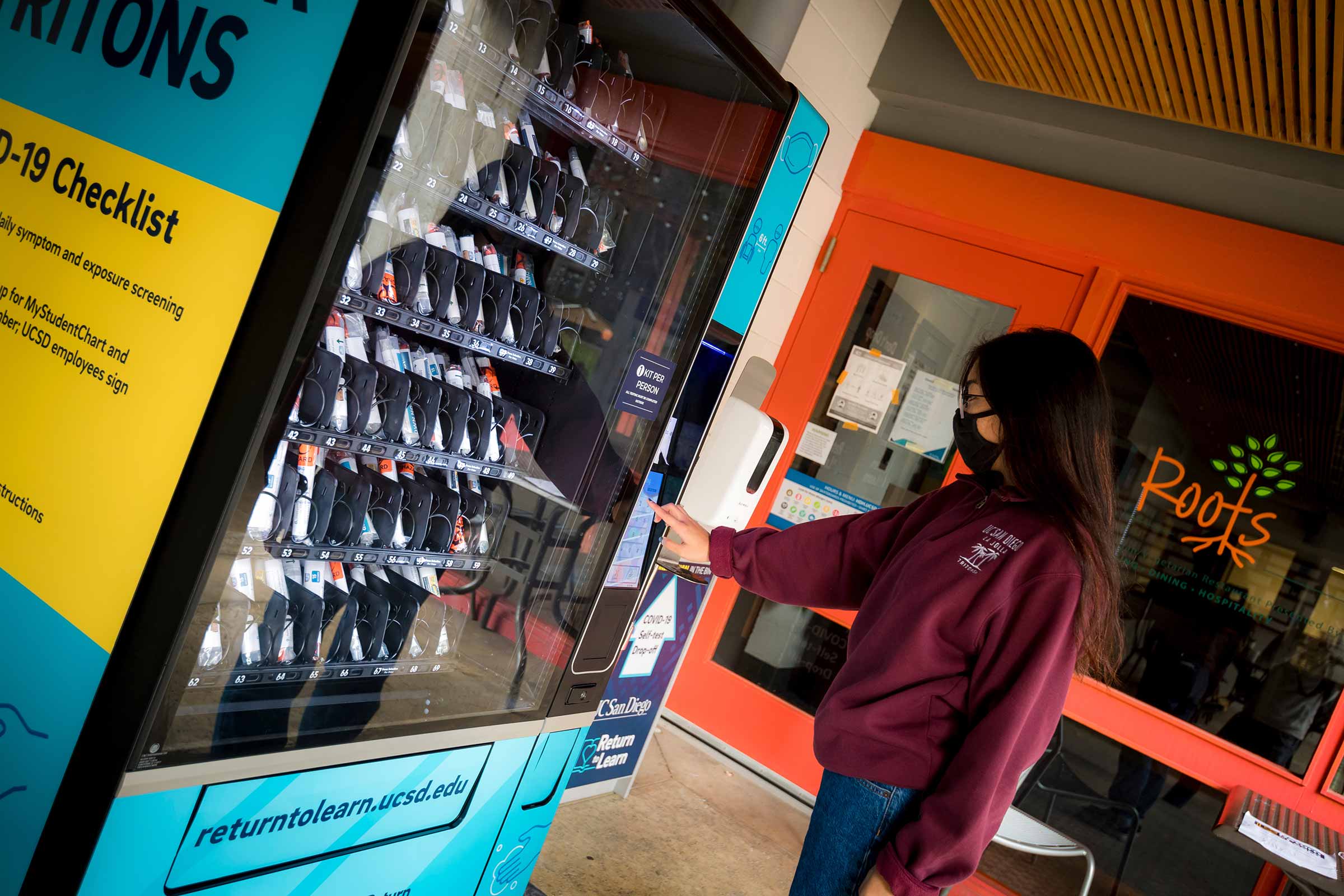
The COVID-19 test kit vending machines distribute up to 2,000 tests. Photos by Erik Jepsen/UC San Diego Communications.
The University of California San Diego is on target to conduct 100,000 COVID-19 student tests in the first two months of winter quarter, a 98 percent increase in testing compared to fall quarter. Student participation in the campus’ Return to Learn weekly mandated testing protocols has helped keep the positivity rate at 0.2 percent, compared to San Diego County’s average of 5 percent. By March 1, UC San Diego will have processed 200,000 student tests.
COVID-19 tests for employees have also been on the uptick, while infection rates have declined. Some 55,000 employee tests have been conducted since March of last year and the positivity rate for the population is 0.1 percent.
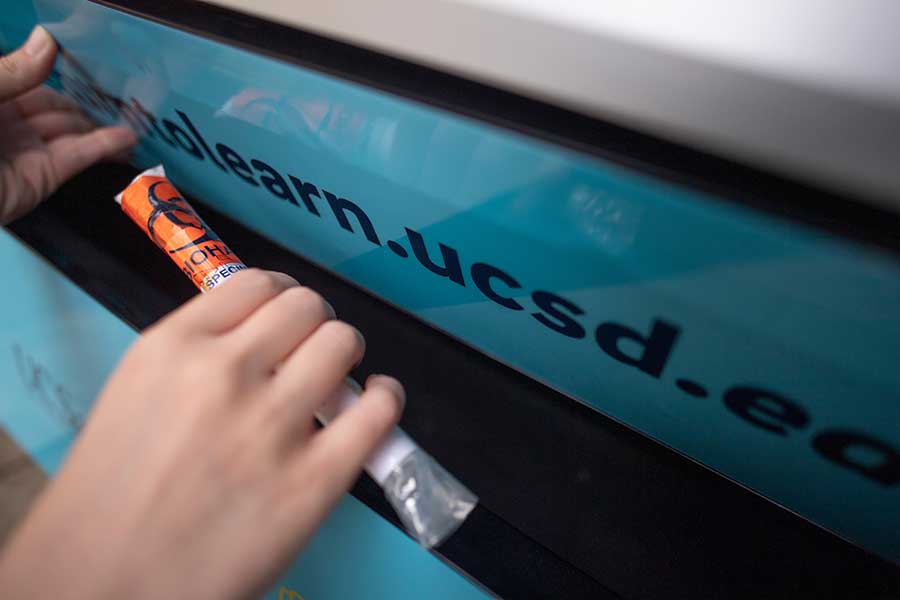
The COVID-19 test kit vending machines’ self-administered tests are the primary method for screening among students.
In addition to increased mandated testing from twice a month to once a week, the installation of COVID-19 test kit vending machines spurred the rapid rise in screening for winter quarter. Distributing up to 2,000 tests per day, the vending machines have been incredibly popular with students and employees. Ten vending machines have been installed on campus to date, with nine more coming soon. The machines—located near residence halls and areas with the most traffic—are the primary source of testing for students.
“Student and employee dedication to daily screening, weekly testing, physical distancing and masking has greatly helped keep our campus and surrounding community safe,” said Chancellor Pradeep K. Khosla. “Adaptability and innovation have been central to our Return to Learn strategy. The Triton culture of working together to spark creative ideas and develop practical solutions trained us for a real-life situation like this pandemic. From the introduction of COVID-19 test kit vending machines, to wastewater monitoring, the CA Notify technology, and other innovations, the entire campus community should be proud of our collective success.”
The campus has more testing capacity than any other university in the state, with two labs processing tests—the Center for Advanced Laboratory Medicine (CALM) and Expedited Covid IdenTification Environment (EXCITE). On average, UC San Diego processes about 5,000 tests per day. Results continue to be fast, often available the next day and sometimes even the same day. The quick results help prevent spread of the virus, allowing rapid notification to students and employees of a positive result, with the prompt movement of positive students into isolation housing. This in turn leads to timely case investigation and contact tracing by campus public health teams.
Staying a step ahead of potential outbreaks
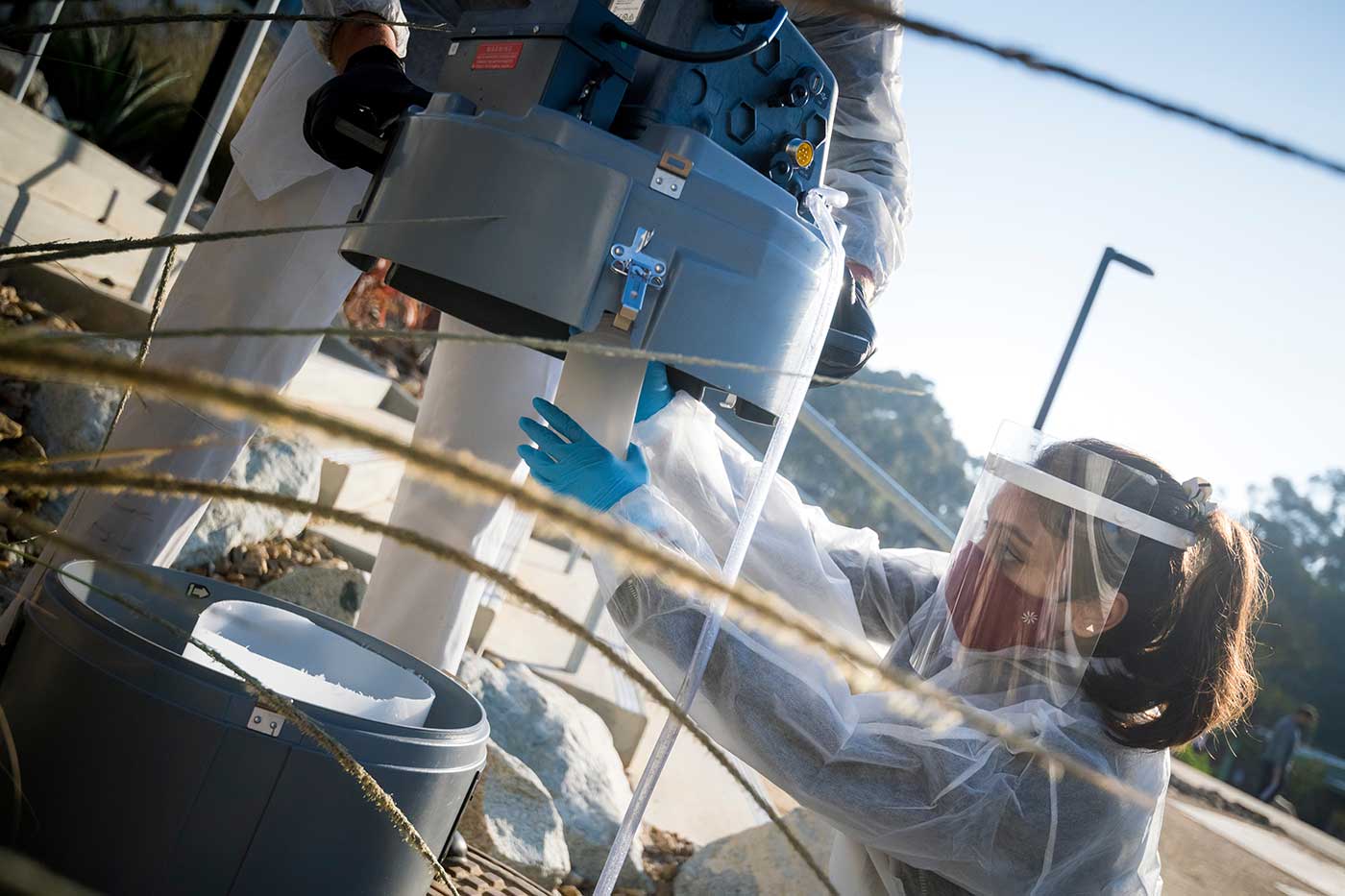
The campus has 109 wastewater samplers, more than any other university in the nation.
Since the start of the pandemic, there have been no outbreaks on the UC San Diego campus.
Key to this effort is wastewater monitoring—another major boon to Return to Learn’s early detection tools for the virus that causes COVID-19. As of Feb. 22, the campus has 109 samplers, more than any other university in the nation. The samplers monitor more than 300 buildings across campus. If a positive signal is detected, individuals in the buildings are encouraged to get tested as soon as possible.
“Our wastewater monitoring helps us detect infections and potential outbreaks at their earliest stage,” said Return to Learn co-lead Natasha Martin, associate professor of medicine at the UC San Diego School of Medicine. “The system is highly sensitive, allowing us to detect a single asymptomatic infection among several hundred building residents.”
The campus ultimately will have 150 samplers installed by the end of winter quarter, covering most residential and non-residential buildings.
Fighting COVID-19 with fresh air
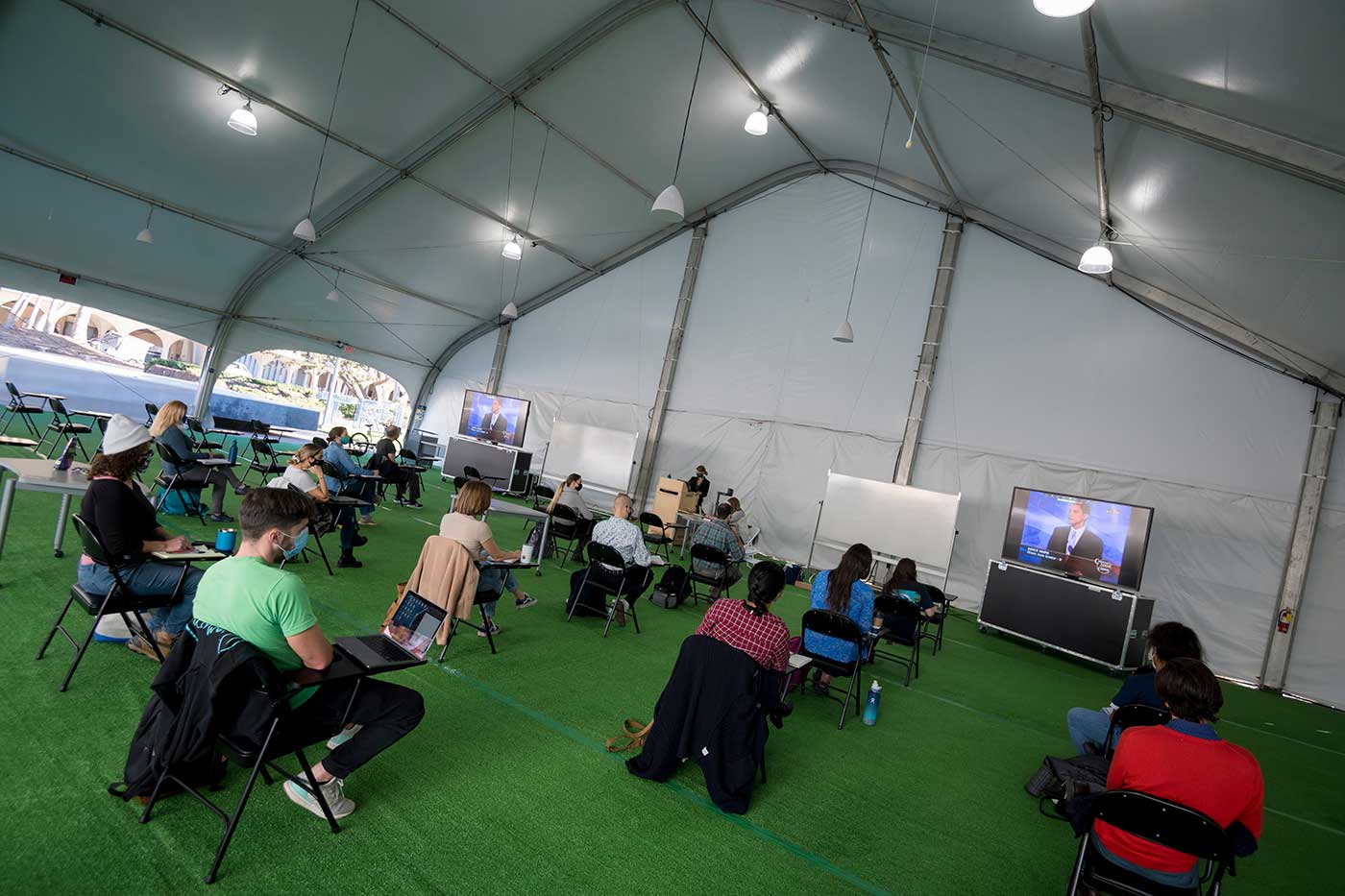
In addition to facilitating in-person learning, the outdoor classrooms feature key technical equipment allowing students to participate virtually in real time across the U.S. and all over the world.
The success of Return to Learn has allowed UC San Diego to continue to offer a world-class educational experience in a safe environment. Throughout winter quarter, more than 2,000 students have been learning in-person through the innovation of UC San Diego’s outdoor classrooms.
The campus constructed six large outdoor classrooms, as well as six outdoor study spaces. The 80-by 60-foot outdoor classrooms are ADA compliant with the capacity to seat up to 50 students physically distanced.
Each space features boosted Wi-Fi, Zoom and podcasting equipment, weatherproof pendant speakers, microphones and large LCD display screens, as well as traditional whiteboards.
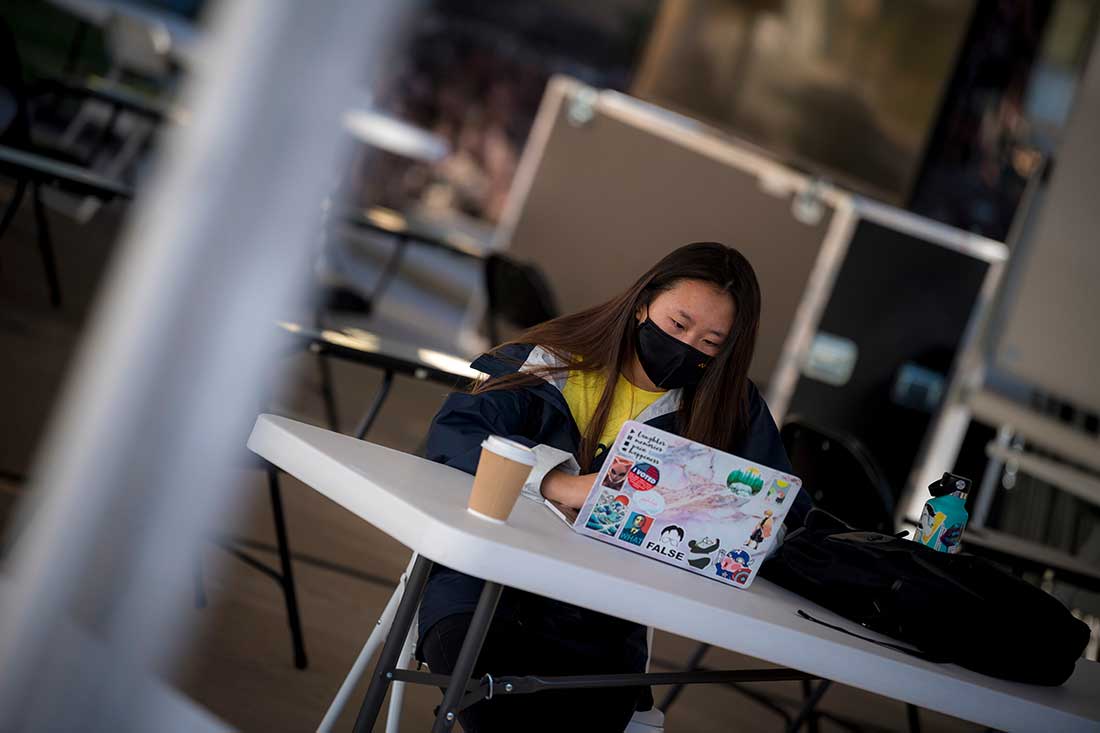
Since the beginning of the pandemic, no evidence of transmission of the SARS-CoV-2 virus has occurred in any UC San Diego (indoor and outdoor) classroom setting.
This key technical equipment allows students to participate virtually in real time across the U.S. and all over the world, while others like School of Global Policy and Strategy graduate student McKenzie Richardson attend in person.
“We are all pretty happy to be here on campus learning,” said Richardson. “I feel lucky to have four classes take place in the tent classrooms. I enjoy the interaction, and you can’t beat being outdoors in San Diego, even in winter.”
In addition to many School of Global Policy and Strategy courses, the campus’ entire Master of Science program chose to shift parts of their programs in person to use the outdoor classrooms. This summer, Scripps Institution of Oceanography graduate programs will utilize the spaces as well.
When public health restrictions are lifted, the university expects to have more than 450 class sections taught in person, with a combined enrollment of 5,800.
UC San Diego classrooms continue to be one of the safest places in the region. Since the beginning of the pandemic, no evidence of transmission of the SARS-CoV-2 virus has occurred in any UC San Diego (indoor and outdoor) classroom setting.
For more information about Return to Learn, go to the program’s website.
Share This:
You May Also Like
Stay in the Know
Keep up with all the latest from UC San Diego. Subscribe to the newsletter today.


